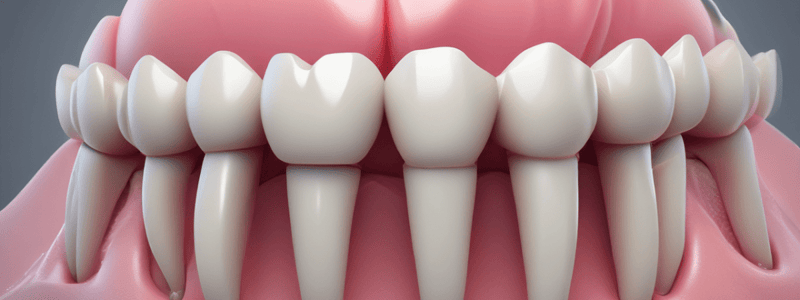Podcast
Questions and Answers
What is the traditional classification of glass ionomer cements?
What is the traditional classification of glass ionomer cements?
- Type I, Type II.1, and Type II.2
- Type I, Type II, Type III, Type IV, Type V, and Type VI
- Type I - Luting, Type II - Restorative, and Type III - Liner or base (correct)
- Type I, Type II, and Type III
Which component of the glass ionomer cement powder is the largest by percentage?
Which component of the glass ionomer cement powder is the largest by percentage?
- Aluminium fluoride
- Alumina
- Silica
- Calcium fluoro-alumino-silicate (correct)
What is the recommended mixing time for glass ionomer cement?
What is the recommended mixing time for glass ionomer cement?
- 40-60 seconds (correct)
- 60-90 seconds
- 20-40 seconds
- 90-120 seconds
Which component of the glass ionomer cement liquid is the largest by percentage?
Which component of the glass ionomer cement liquid is the largest by percentage?
What is the working time for glass ionomer cement?
What is the working time for glass ionomer cement?
Which of the following is not a traditional classification of glass ionomer cements?
Which of the following is not a traditional classification of glass ionomer cements?
What is the main purpose of a cavity varnish?
What is the main purpose of a cavity varnish?
What is the main advantage of using a dual-cure resin cement system?
What is the main advantage of using a dual-cure resin cement system?
What is the main function of calcium hydroxide when used as a cavity liner?
What is the main function of calcium hydroxide when used as a cavity liner?
What is the main disadvantage of using calcium hydroxide as a cavity liner?
What is the main disadvantage of using calcium hydroxide as a cavity liner?
What is the main purpose of etching the tooth surface and the restoration surface before applying a resin cement?
What is the main purpose of etching the tooth surface and the restoration surface before applying a resin cement?
What is the main function of a silane coupling agent when used in a resin cement system?
What is the main function of a silane coupling agent when used in a resin cement system?
What is the primary function of Glass Ionomer Cements?
What is the primary function of Glass Ionomer Cements?
What is a potential disadvantage of using Glass Ionomer Cements?
What is a potential disadvantage of using Glass Ionomer Cements?
What is the primary purpose of Resin Cements?
What is the primary purpose of Resin Cements?
Which of the following is NOT a type of Resin Cement mentioned in the text?
Which of the following is NOT a type of Resin Cement mentioned in the text?
What is a key component of Filled Resin Cements?
What is a key component of Filled Resin Cements?
Which of the following is NOT mentioned as a clinical use of Resin Cements?
Which of the following is NOT mentioned as a clinical use of Resin Cements?
What is the primary advantage of glass ionomer cement over other cements?
What is the primary advantage of glass ionomer cement over other cements?
Which cement type exhibits chemical bonding to both enamel and dentin?
Which cement type exhibits chemical bonding to both enamel and dentin?
What is the primary disadvantage of resin cements compared to glass ionomer cements?
What is the primary disadvantage of resin cements compared to glass ionomer cements?
What is the purpose of using a silane coupling agent in resin cement systems?
What is the purpose of using a silane coupling agent in resin cement systems?
Which type of resin cements is no longer used in modern dentistry?
Which type of resin cements is no longer used in modern dentistry?
For what clinical use are resin cements commonly employed?
For what clinical use are resin cements commonly employed?
What is the primary function of a cavity varnish?
What is the primary function of a cavity varnish?
What is the main purpose of etching the tooth surface and the restoration surface before applying a resin cement?
What is the main purpose of etching the tooth surface and the restoration surface before applying a resin cement?
Which of the following is the main disadvantage of using calcium hydroxide as a cavity liner?
Which of the following is the main disadvantage of using calcium hydroxide as a cavity liner?
What is the primary function of a silane coupling agent when used in a resin cement system?
What is the primary function of a silane coupling agent when used in a resin cement system?
What is the main advantage of using a dual-cure resin cement system?
What is the main advantage of using a dual-cure resin cement system?
What is the primary purpose of Resin Cements?
What is the primary purpose of Resin Cements?
What is the purpose of dividing the powder into two equal portions during the manipulation of glass ionomer cement?
What is the purpose of dividing the powder into two equal portions during the manipulation of glass ionomer cement?
What is the significance of the loss of glossiness on the surface of the mixed glass ionomer cement?
What is the significance of the loss of glossiness on the surface of the mixed glass ionomer cement?
Which component of the glass ionomer cement liquid serves as a chelating agent?
Which component of the glass ionomer cement liquid serves as a chelating agent?
What is the recommended maximum time for the mixing of glass ionomer cement?
What is the recommended maximum time for the mixing of glass ionomer cement?
Which component of the glass ionomer cement powder serves as a source of fluoride ions?
Which component of the glass ionomer cement powder serves as a source of fluoride ions?
Which of the following statements about the manipulation of glass ionomer cement is correct?
Which of the following statements about the manipulation of glass ionomer cement is correct?




